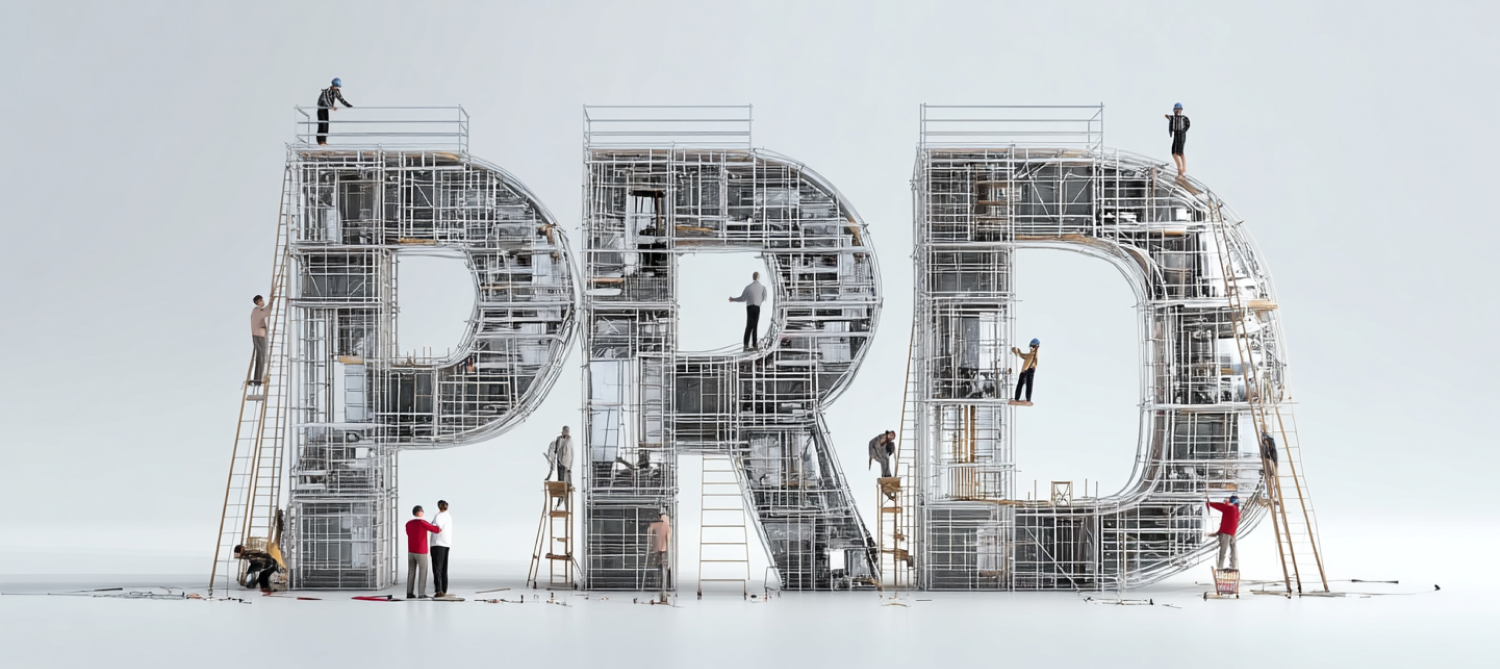When AI starts writing code, designing interfaces, and generating user flows, the real benefit isn’t speed, it’s coordination. The Product Requirements Document (PRD) is re-emerging as a new kind of Copilot, aligning product, design and tech teams with AI as the silent coordinator.
This article continues from my previous post, “How AI just changed the rules of rapid prototyping”. While that explored how vibe coding accelerates the path from idea to pilot, this one looks at what keeps that speed aligned inside modern organisations.
From ad-hoc experiments to stable releases
Vibe coding, coined in early 2025, made it possible to prototype through conversational AI rather than writing code. It gave teams super-speed but also exposed a new fragility: alignment.
Here is a short intro video from Lovable about their Vibe coding promise.
Designers and developers can now build solutions in minutes (over 40% of GitHub code is now generated by AI). But without a shared process, Vibe coding can become chaotic and unstable, development dependencies can be unclear, and user validation can be inconsistent.
AI and Vibe coding can easily amplify governance gaps if not curated well.
So to benefit from this potential, teams need structure and a stabiliser that keeps intent, experimentation and delivery connected and coordinated.
That stabiliser could potentially be the AI-powered PRD template.
A Product Requirements Document explains what should be created, who it’s for, and why it matters, so that product, design and tech work toward the same goal. In the AI era, it becomes a translator between human intent and machine execution, turning ideas into clear, testable outcomes
From documents to dialogues
The old PRDs were static and slow to maintain for product owners.
In the AI-first era, PRDs are becoming the platform for living conversations between teams and intelligent systems, shaping how ideas move through design, development and validation.
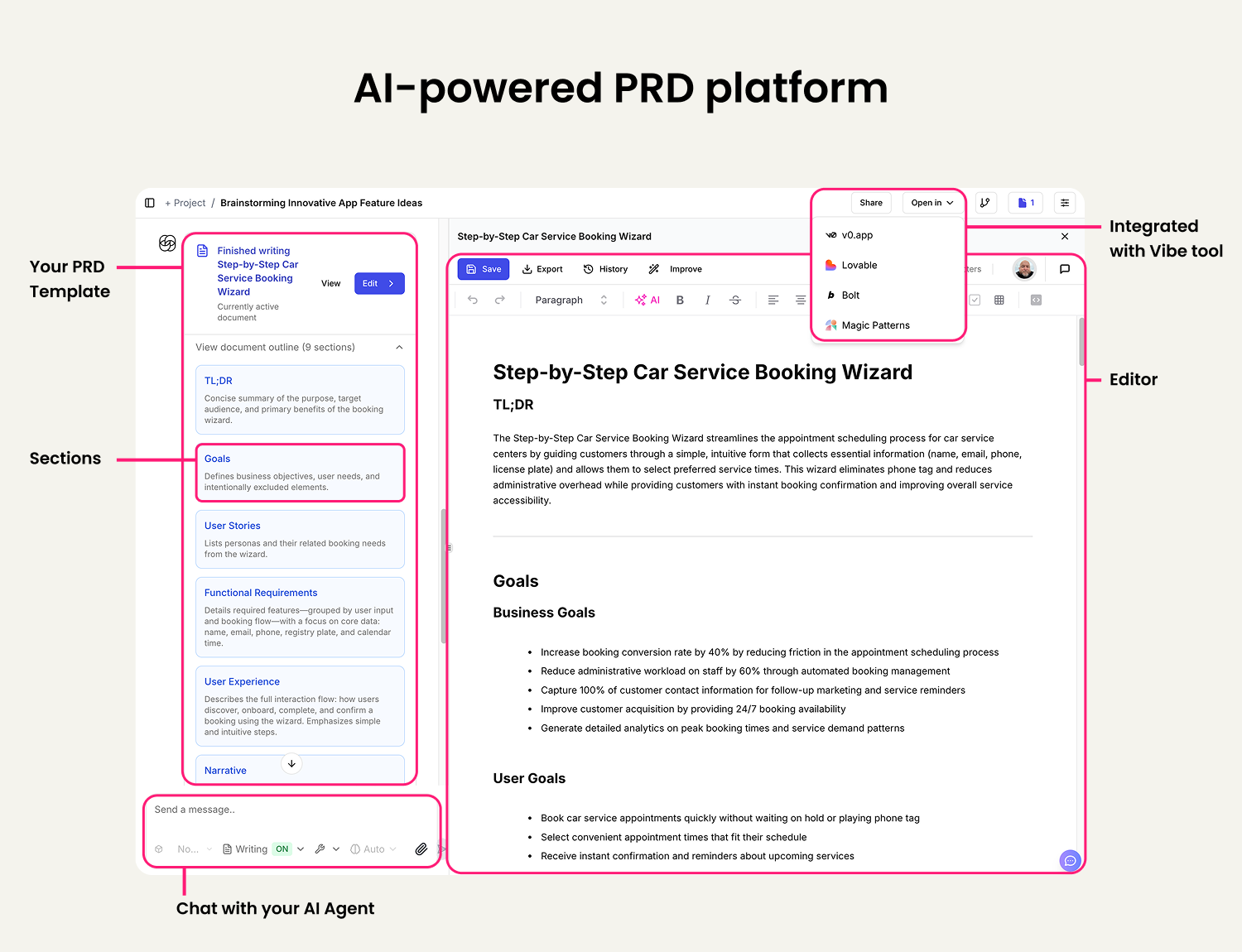
Applying a PRD Copilot to your development process
Connected to your development process, the PRD used as a Copilot can act as the connective tissue that holds together modern product work for all your stakeholders. I have broken down the Triple Diamond into a reference example of how you can benefit from the PRD in each phase.

1. Define - shared intent and purpose
Every initiative, feature request or product discovery starts with your intent and purpose.
So, in the first diamond, the PRD Copilot can coach you to capture why something should exist, who it serves and what outcome it should create, and how success will be measured. And this can be done with guided conversations by your PRD platform.
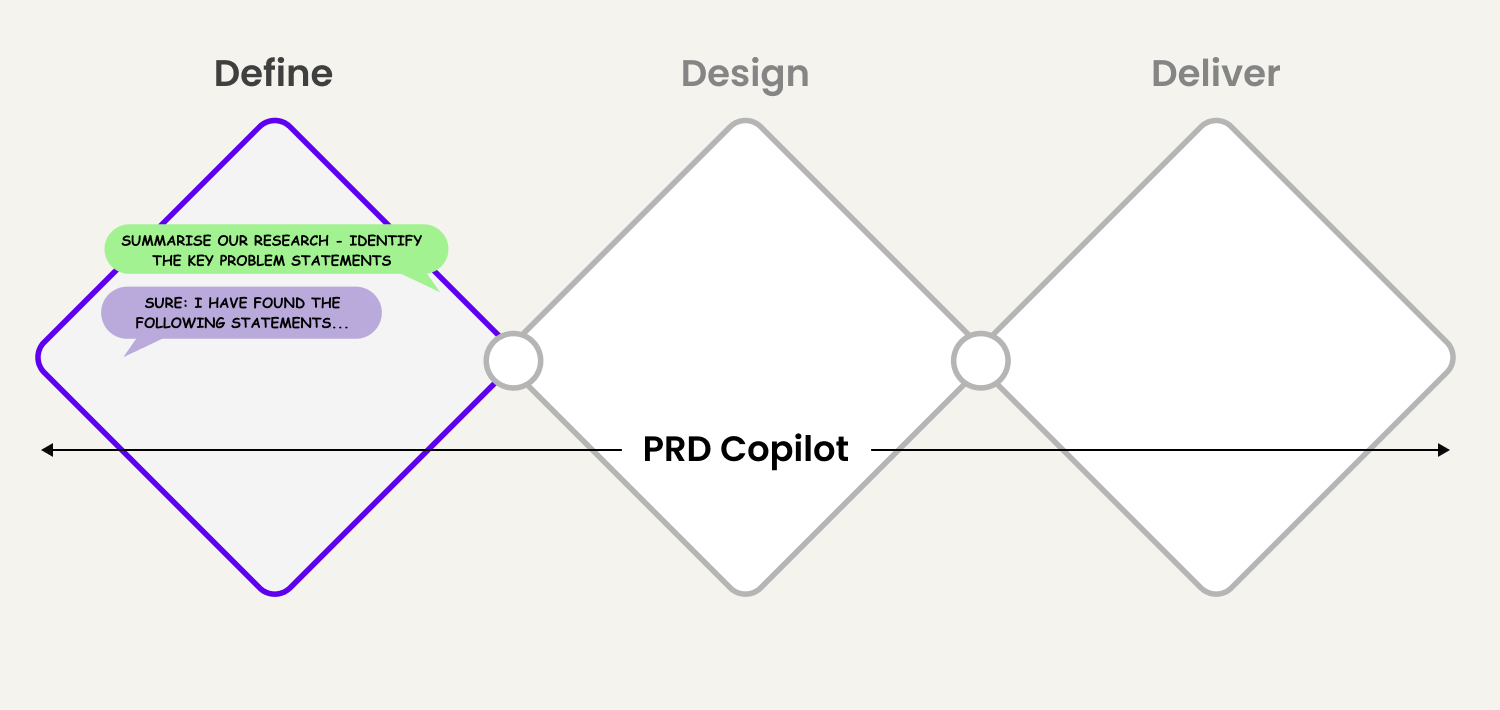
The AI-powered PRD chat can then translate your intent and purpose into structured sections within your template.
You can set up your procedures as sections and ensure that you have a standard process for how you:
- define user context
- structure tasks and expectations
- articulate hypotheses
- validate with users
- define success metrics
- estimate efforts for budgeting reasons
- prioritise efforts
- manages cost structures
- followup progress
- ...and so on
As you see above, your user-centricity can be established right from the start in your development process. Your PRD now becomes the strategic compass that aligns your team, human and machine, on the same intent and purpose.
2. Design - context alignment
The second diamond focuses on cross-team alignment, solving the rights problems and validate its relevance and value with targed users withour investing too much.
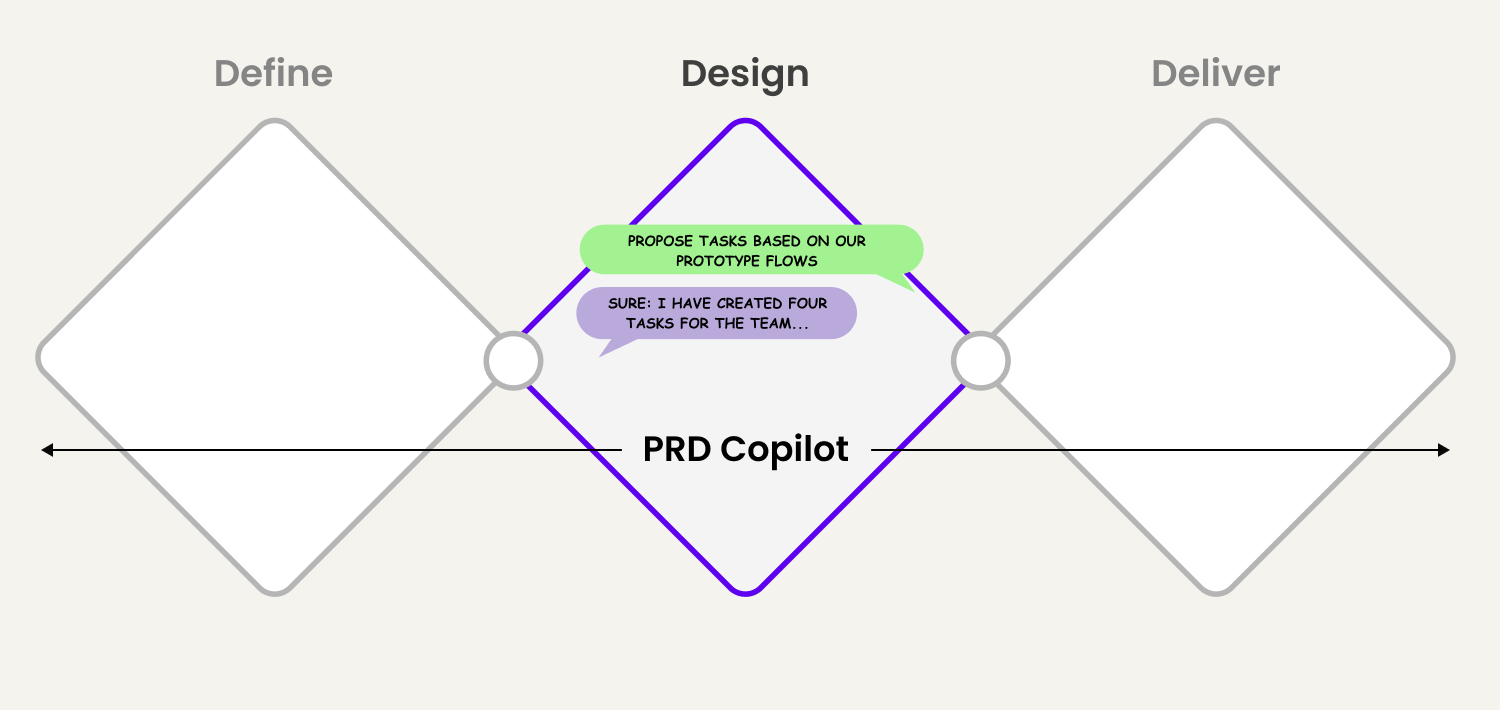
With your PRD as the foundation for your Vibe coding practice, prototyping can now establish deeper alignment between design and technology.
Your PRD sections can now guide your planning for how you:
- Define your user journeys to prototype
- Establish data models and automations
- Curate your engagement models
- Funnel architecture and team collaborations
- Validation with reference groups
- Analyse how to implement and launch
As you see above, your previous step can now be used in your design phase. Your PRD can serve as the backbone for priorities, user engagement, and validation.
3. Deliver - curating knowledge and learnings
In the final diamond, the PRD shifts from guiding creation to capturing knowledge, highlighting learning along the journey.
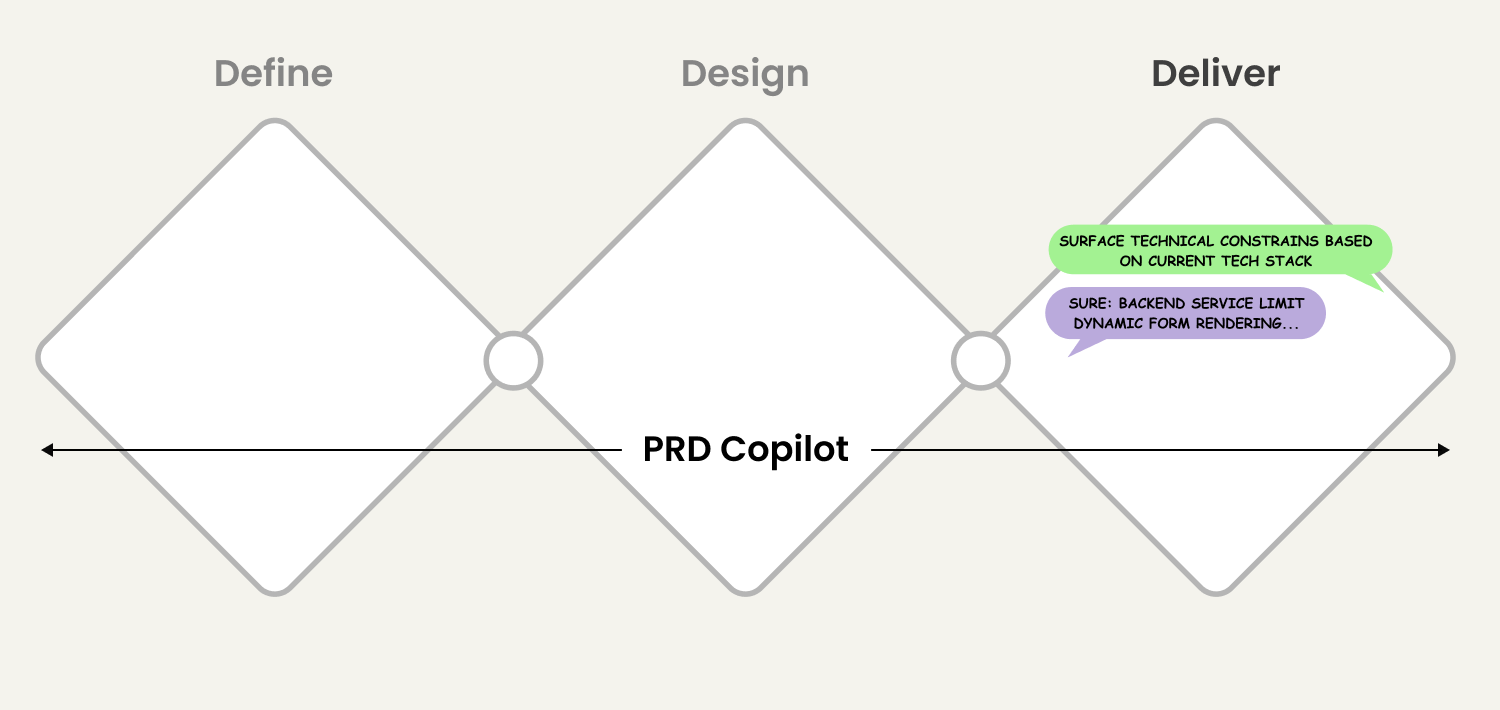
As prototypes evolve into pilots, AI can analyse outcomes, flag deviations, and feed insights back into the same document. Because experimentation can be part of the PRD template, learning loops can be secured and coordinated with automation.
The PRD becomes a self-updating knowledge system that helps teams mature product-market fit, reduce duplication, and grow their institutional memory.
This example shows how AI can truly become the coordinator, connecting people, processes, and platforms that continuously improve themselves.
Turning the PRD into a coordination engine
The rise of AI-assisted PRD platforms shows this evolution in motion.
These tools transform your ideas into a structured document - drafting requirements, surfacing dependencies, and even suggesting success metrics.
Integrated with toolboxes like Figma, Notion, Linear and Jira, they make the PRD a live coordination hub:
- Product leads can instantly generate draft PRDs.
- Designers can prototype user flows before alignment meetings.
- Developers can ensure that the tech stack is adopted early in the process.
- Researchers feed validation data directly into the same artefact, closing the loop between insight and iteration.
In this curated environment, AI doesn’t replace your team's collaboration; it coordinates it and makes it lean. It detects gaps, proposes consistent terminology and ensures every iteration builds on the same foundation.
ChatPRD calls this “AI as your Chief Product Officer” - maybe a provocative glimpse of a machine-assisted future, where AI-governance models keep intent, design and delivery connected to us humans. Let us look back in some years to see if they were right.
How to start
To make AI productive and sustainable, start by restarting your PRD process into a modern governance model built around four lenses: user intent, data logic, technical feasibility and business viability. By creating your relevant sections from these lenses, AI can automatically coordinate updates, trace dependencies, and maintain coherence.
With your new PRD templates as shown above, every team can be accountable for contributing early - ensuring that AI can represent all teams (and end users) interests, and to surface dependencies and trace decisions back to intent and purpose.
The result of this isn’t just improved speed, it’s more about clarity, transparency and collective learning how to work with AI across your teams.
Why it matters
While AI now accelerates the creation process, the differentiator isn’t just automation - it’s alignment. The organisations that win will be those who synchronise best: combining speed with validation and automation with human intent.
The PRD, once dismissed as bureaucracy, is becoming the operating system of collaboration, translating human goals into machine logic while keeping teams grounded in user reality.
In an age where AI can build anything, the question is no longer “Can we?” but “How do we stay aligned while doing it?”
The AI-powered PRD gives that answer shape and structure.
Closing reflection
AI has redefined how work is produced, but meaningful progress still depends on coordination from the leadership team in the transition phase.
When the PRD becomes the shared space for intent, experimentation, and validation, AI helps teams think together - not faster, but more brilliant and more sustainably.
The next evolution of work isn’t automation.
It’s shared understanding at machine speed.
Want to get started?
If your teams are exploring AI-driven design, development or experimentation but struggle to stay aligned, let’s talk.
Together, we can design your PRD templates and governance models that leverage AI to support coordination, validation, and learning across your teams.
Reach out, and let’s build AI-powered alignment that lasts.
Want to explore?
I help organisations turn intent into impact by integrating AI-powered PRD templates with rapid prototyping, vibe coding, and pilot validation.
Learn moreRelated articles




